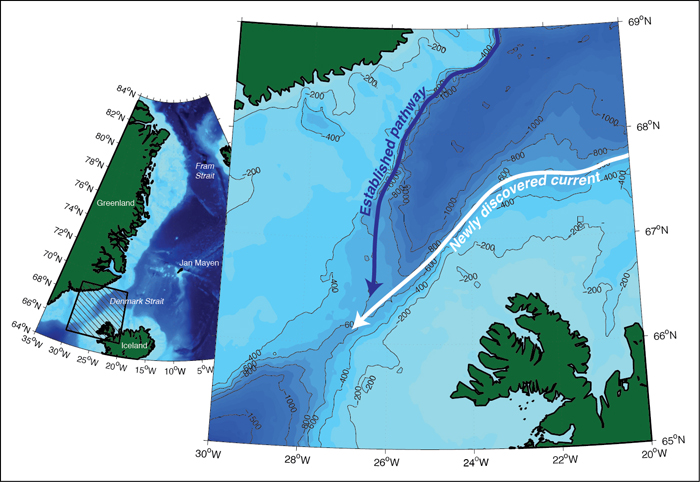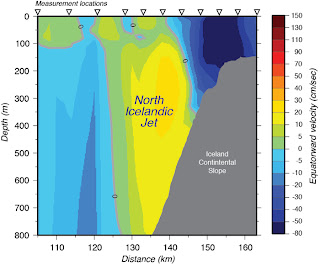Search Geography Section
Monday, August 22, 2011
Newly Discovered Icelandic Current Could Change North Atlantic Climate Picture
An international team of researchers, including physical oceanographers from the Woods Hole Oceanographic Institution (WHOI), has confirmed the presence of a deep-reaching ocean circulation system off Iceland that could significantly influence the ocean’s response to climate change in previously unforeseen ways.
The current, called the North Icelandic Jet (NIJ), contributes to a key component of the Atlantic Meridional Overturning Circulation (AMOC), also known as the “great ocean conveyor belt,” which is critically important for regulating Earth's climate. As part of the planet’s reciprocal relationship between ocean circulation and climate, this conveyor belt transports warm surface water to high latitudes where the water warms the air, then cools, sinks, and returns towards the equator as a deep flow.
Crucial to this warm-to-cold oceanographic choreography is the Denmark Strait Overflow Water (DSOW), the largest of the deep, overflow plumes that feed the lower limb of the conveyor belt and return the dense water south through gaps in the Greenland-Scotland Ridge.
For years it has been thought that the primary source of the Denmark Overflow is a current adjacent to Greenland known as the East Greenland Current. However, this view was recently called into question by two oceanographers from Iceland who discovered a deep current flowing southward along the continental slope of Iceland. They named the current the North Icelandic Jet and hypothesized that it formed a significant part of the overflow water.
“In our paper we present the first comprehensive measurements of the NIJ,” said Robert S. Pickart of WHOI, one of the authors of the study. “Our data demonstrate that the NIJ indeed carries overflow water into Denmark Strait and is distinct from the East Greenland Current. We show that the NIJ constitutes approximately half of the total overflow transport and nearly all of the densest component.
The researchers used a numerical model to hypothesize where and how the NIJ is formed. “We’ve identified a new paradigm,” he said. “We’re hypothesizing a new, overturning loop” of warm water to cold.
While this scenario is far from certain, it is critical that researchers understand the overturning process, he said, to be able to make accurate predictions about the future of climate and circulation interaction. “If a large fraction of the overflow water comes from the NIJ, then we need to re-think how quickly the warm-to-cold conversion of the AMOC occurs, as well as how this process might be altered under a warming climate,” Pickart said.
“These results implicate local water mass transformation and exchange near Iceland as central contributors to the deep limb of the Atlantic Meridional Overturning Circulation, and raise new questions about how global ocean circulation will respond to future climate change,” said Eric Itsweire, program director in the U.S. National Science Foundation (NSF)’s Division of Ocean Sciences, which funded the research.
The Research Council of Norway also funded the analysis of the data.
“During our upcoming cruise on the Knorr we will, for the first time, deploy an array of year-long moorings across the entire Denmark Strait to quantify the NIJ and distinguish it from the East Greenland Current,” Pickart said. “Then we will collect shipboard measurements in the Iceland Sea to the north of the mooring line to determine more precisely where and how the NIJ originates.”
In addition to Pickart, authors of the Nature Geoscience study include Michael A. Spall, and Daniel J. Torres of WHOI, lead author Kjetil Våge, a graduate of the MIT-WHOI joint program now with University of Bergen, Norway, Svein Østerhus and Tor Eldevik, also of the University of Bergen, Norway, and Héðinn Valdimarsson and Steingrímur Jónsson—the two discoverers of the NIJ—of the Marine Research Institute in Reykjavik, Iceland.
The Woods Hole Oceanographic Institution is a private, independent organization in Falmouth, Mass., dedicated to marine research, engineering, and higher education. Established in 1930 on a recommendation from the National Academy of Sciences, its primary mission is to understand the ocean and its interaction with the Earth as a whole, and to communicate a basic understanding of the ocean's role in the changing global environment.
This article was a news release from the Woods Hole Oceanographic Institution.
Subscribe to:
Post Comments (Atom)





No comments:
Post a Comment